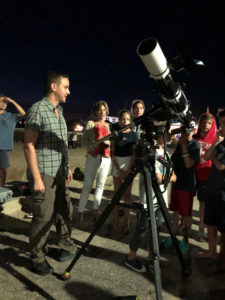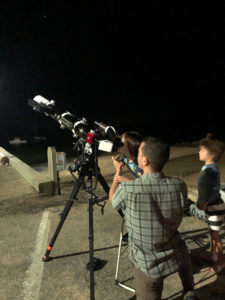
The planets Jupiter and Saturn returned to the evening sky last month and will be with us through autumn. Jupiter looks like a brilliant white-gold star, and Saturn is a dimmer, rich gold color. They’re a beautiful sight against the night sky, but bright objects like these can be seen earlier, just after sunset, when the sky is still blue.
Here is a clever celestial navigation trick to find them.
By a convenient quirk of human anatomy, your fist held out at arm’s length covers about 10 degrees of the sky. You can use this to direct your gaze to specific positions. Try this: extend your arm straight out in front of you and make a fist. Turn your fist vertical (thumb-side up). Now make sure your thumb is on top of your fist, not tucked in. With the heel of your fist resting on the horizon, the bump of your thumb knuckle now marks a spot in the sky about 10 degrees above it. Placing your other fist on top of the first moves you up to 20 degrees relative altitude. Leapfrog your fist again, and you’re at 30 degrees above the horizon.
Now that you have the technique down, on to the fun part. First, find a place where you have a clear view to the south (a beach, big parking lot, or open field). Then stand facing south after sunset; currently 7:30 p.m. Using your new navigation technique, raise your gaze to 25 degrees altitude (two and a half fists, stacked vertically).

Slowly scan back and forth, until you see a star shining against the dark blue sky. Only it’s not a really a star. It’s Jupiter.
Now move your eyes left of Jupiter, a little east of south, and drop half a fist to 20 degrees altitude. Look carefully for a dimmer, gold star — that’s Saturn. It’s harder to find than Jupiter, since it’s not as bright, and you might not see it until closer to 8 o’clock.
Seeing how early you can catch these planets and watching them as they move across the night sky is a good way to train your astronomical eye. Next time: more about the detail you can see of both planets with your eyes, binoculars, and small telescopes. Clear skies!
Note to readers who are not on the Outer Cape: Jupiter and Saturn are visible everywhere right now, and the altitude figures given will work from roughly the latitudes of Washington DC to Montreal. The further south you are, the higher the altitude of Jupiter and Saturn will be. The further north, the lower the altitude. If you want to learn more, look for astronomical almanacs online. They will tell you the altitude in degrees of objects in the sky at your location for a given time and date.



